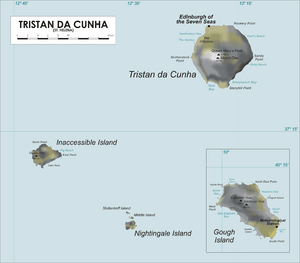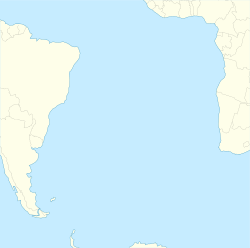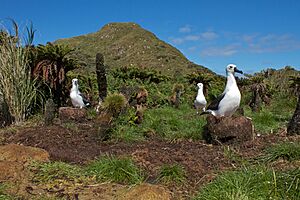Nightingale Island facts for kids

Nightingale Island's location in relation to Tristan da Cunha
|
|
| Geography | |
|---|---|
| Location | South Atlantic Ocean |
| Coordinates | 37°25′10″S 12°28′40″W / 37.419444°S 12.477778°W |
| Archipelago | Tristan da Cunha |
| Area | 3.2 km2 (1.2 sq mi) |
| Length | 1.5 km (0.93 mi) |
| Width | 2.5 km (1.55 mi) |
| Highest elevation | 370 m (1,210 ft) |
| Highest point | High Peak |
| Administration | |
|
United Kingdom
|
|
| St Helena, Ascension and Tristan da Cunha | |
Nightingale Island is a small, active volcanic island in the South Atlantic Ocean. It covers about 3 square kilometers (1.2 square miles). This island is part of the Tristan da Cunha group of islands. These islands are managed by the United Kingdom as part of its overseas territory called Saint Helena, Ascension and Tristan da Cunha.
Nightingale Island is one of three islands in the Nightingale Islands group. The other two are tiny islets called Middle Island and Stoltenhoff Island. No one lives on any of these three islands. However, scientists and researchers visit them often to study their unique nature.
Contents
Island Geography and Features
Nightingale Island has two main peaks on its northern side. One peak is about 337 meters (1,106 feet) high, and the other is 293 meters (961 feet) high. Cliffs surround most of the island. But these cliffs are not as tall as those on its neighbor, Inaccessible Island, which is about 16 kilometers (10 miles) away. Inaccessible Island has cliffs that are around 300 meters (984 feet) high. This makes it much easier for people to land on Nightingale Island than on Inaccessible Island.
The island is a volcano. It is made up of old ash layers and hardened lava flows. Scientists believe the last eruption happened over 39,000 years ago, before a smaller event in 2004.
The two small islets nearby are Stoltenhoff, which is 99 meters (325 feet) high, and Middle, which is 46 meters (151 feet) high.
A lot of kelp (a type of seaweed) grows around Nightingale Island. This thick kelp can make it hard for ships to drop anchor safely, especially when the weather is bad.
Island Climate
Nightingale Island has an oceanic climate. This means it has mild temperatures and plenty of rain throughout the year. Its weather is similar to the other islands in the Tristan da Cunha group.
Island History and Discoveries
Nightingale Island might have been seen in 1506 by Tristão da Cunha, who also discovered Tristan da Cunha. But he didn't write anything about it.
In January 1656, a Dutch ship named the Nachtglas called the island "Gebrooken Eyland," meaning "Broken Island." The crew couldn't find a safe place to anchor. The first time someone actually landed on the island was likely in 1696.
In September 1767, French captain Pierre d'Etcheverry visited the island. He was the first to record the two small islets nearby, which are now called Stoltenhoff and Middle. The island was later named after British captain Gamaliel Nightingale, who explored it in 1760.
In the 17th and 18th centuries, several governments thought about taking over Nightingale Island. These included the Dutch and French governments and the British East India Company. But they decided not to because it was hard to find a good landing spot.
Pirate Treasure Stories
Some stories say that Nightingale Island hides pirate treasure! Captain John Thomas, an American pirate, was on an expedition in the South Atlantic. He supposedly hid a lot of Spanish gold coins (called doubloons) and silver coins (called pieces-of-eight) in caves on Nightingale Island to keep them safe. However, no one has ever found or confirmed this treasure.
In 1811, another American pirate named Jonathan Lambert claimed Tristan da Cunha and its nearby islands. He wanted to rename Inaccessible Island to 'Pinsard Island' and Nightingale Island to 'Lavel Island'. He succeeded in his claim, but he died less than a year later.
Volcanic Eruption and Evacuation
In 1961, the volcano on Tristan da Cunha erupted. This forced all the people living there to move to Nightingale Island for safety. They later moved to the United Kingdom and returned to Tristan da Cunha in 1963.
Conservation Efforts
People are working hard to protect the wildlife on Nightingale Island. In 2001, a big storm with winds up to 120 miles per hour badly damaged the buildings used by conservation workers. Repairing these buildings is important to continue the conservation work. The United Kingdom provided money for conservation efforts on Nightingale from 2004 to 2006.
2004 Underwater Eruption
On July 29, 2004, a series of small earthquakes happened around Nightingale Island for six hours. After this, people saw floating pieces of light, bubbly rock (called pumice). This showed that a volcano erupted underwater on the side of the island.
2011 Oil Spill
On March 16, 2011, a large cargo ship called the MS Oliva crashed near Spinners Point on the island's northwest shore. This caused a big oil spill that spread around the island. The spill was a huge danger to the seabirds living on Nightingale and Middle Island.
The ship carried 1,500 metric tons of crude oil and 60,000 metric tons of soya beans. About 20,000 penguins were at risk. There was also a worry that rats from the ship could get onto the island. These rats could then eat the eggs and chicks of native seabirds. Since Nightingale Island has no fresh water, the penguins had to be taken to Tristan da Cunha to be cleaned. The ship's captain and crew helped the islanders with the cleanup.
Amazing Island Wildlife
Nightingale Island is famous as a place where many types of seabirds come to breed. It's estimated that over a million birds make their nests on the island. Great shearwaters are one of the most common birds found here.
The island has four wetland areas. Each of these areas is home to hundreds of Atlantic yellow-nosed albatrosses. Like Inaccessible Island, Nightingale also has a breeding colony of northern rockhopper penguins. These penguins are now an endangered species, meaning their numbers are much lower than they used to be.
BirdLife International has named the Nightingale Islands group an Important Bird Area (IBA). This means it's a very important place for breeding seabirds and birds that only live on these islands.
Visiting Nightingale Island
While Inaccessible and Gough Islands are strict nature reserves where tourists are not allowed, Nightingale Island is open to visitors.
Many tourists who visit Tristan da Cunha also travel to Nightingale Island to see its amazing wildlife. If you are not from Tristan, you must go with a guide from the island. Part of the money paid to the guide helps support the conservation work on the island.
Once a year, filmmakers and journalists can get permission to work on the island (for a fee). However, they are not allowed to bother the private lives of the Tristanian islanders. People from Tristan da Cunha also visit Nightingale for holidays.
Island Economy
Fishing companies often fish in the waters around Nightingale Island, just like they do near Inaccessible Island.
Nightingale Island also has deposits of guano, which is bird droppings that can be used as fertilizer.
Several special collector coins have been made for Nightingale Island. These include silver and copper-nickel coins issued in 2005 and 2006. In 2011, Tristan da Cunha released a full series of coins for Nightingale Island, with values from ½ penny to £2. These coins often feature local wildlife, such as:
- Subantarctic fur seal
- Mahi-mahi
- Oarfish
- Blue shark
- Octopus
- Bluefin tuna
- Swordfish
- Flyingfish
See also
In Spanish: Isla del Ruiseñor para niños




